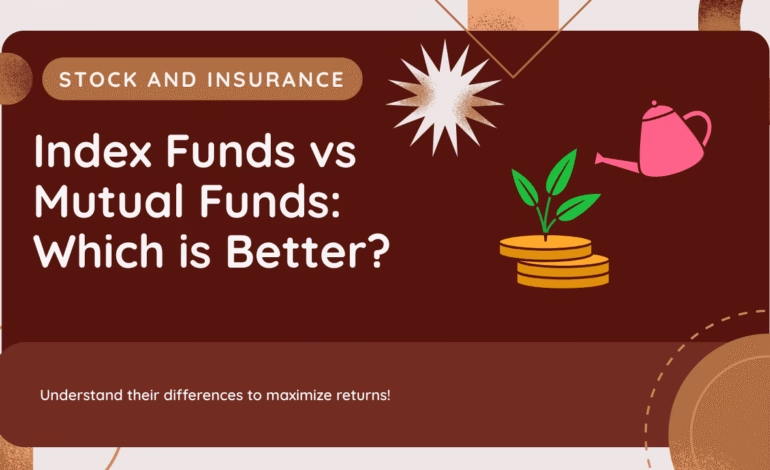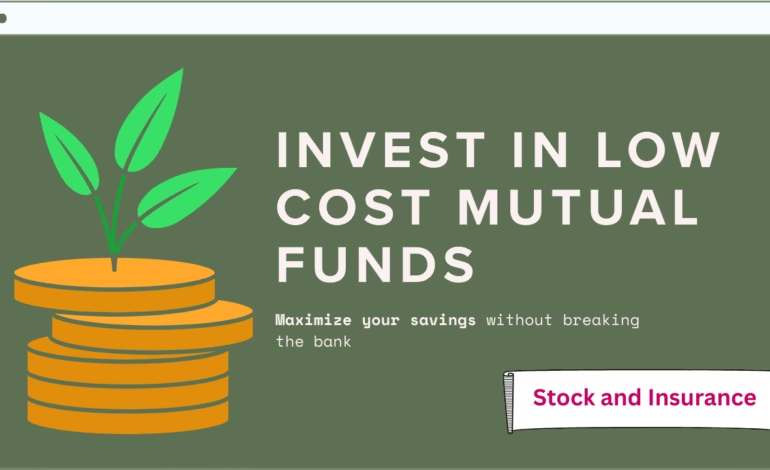
When we talk about building long-term wealth, one investment category consistently stands out: low cost mutual funds. As we step closer to 2026, investors in Tier 1 countries such as the United States, the United Kingdom, Canada, Singapore, and Australia are increasingly turning toward the best mutual funds for developed markets. These funds provide a strong mix of mutual funds for long term growth and diversified exposure to developed market growth funds 2026 without demanding high management fees.
In this blog, I will explain why low cost mutual funds are one of the smartest strategies for future-proofing your portfolio, what makes developed markets a strong choice in 2026, and how you can position yourself for sustainable long-term success.
Why Low Cost Mutual Funds Are Attracting Investors in 2026
Consider this scenario. Would you rather pay a fund manager 1.5 percent every year for managing your investments, or keep that money in your account compounding for decades? Most of us would choose the second option. That is the philosophy behind low cost mutual funds.
Traditional mutual funds can charge management fees anywhere from one to two percent annually. Low cost funds, especially index mutual funds, often charge less than 0.20 percent.
Now imagine investing one hundred thousand dollars in a developed market growth fund and leaving it untouched for twenty years with a 7 percent annual return. The difference between paying 1.5 percent in fees versus 0.15 percent could result in tens of thousands of dollars more in your portfolio.
This is why low cost mutual funds are not just a passing trend. They are becoming the global standard for smart investors who want higher efficiency, better compounding, and consistent long-term growth.
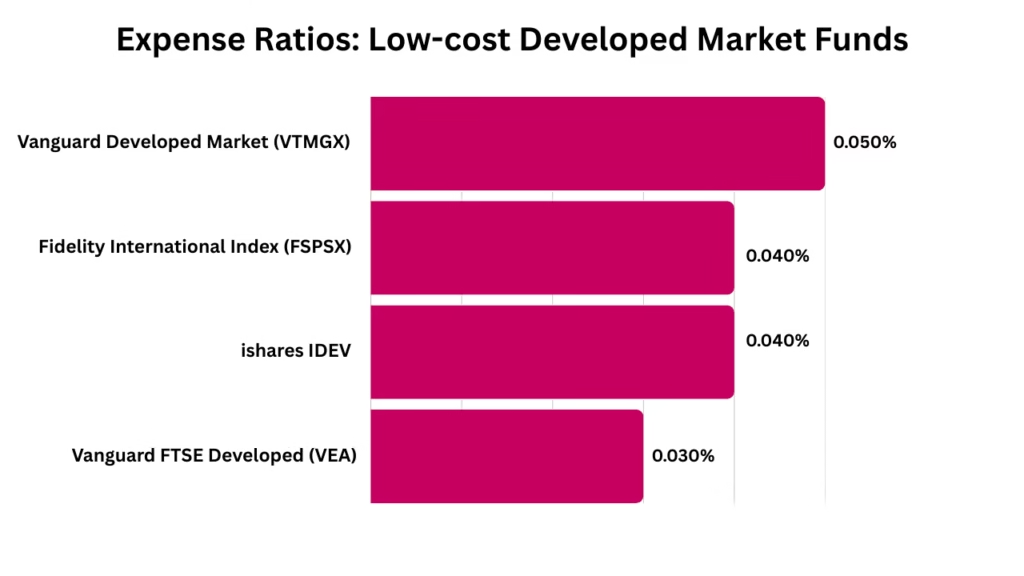
Developed Market Growth Funds 2026: Why the Timing Matters
Why should investors pay special attention to developed market growth funds in 2026? Developed markets such as the United States, the United Kingdom, Japan, Germany, Canada, Singapore, and Australia are often viewed as stable but not always the fastest growing. However, the coming years reveal strong reasons to focus on them.
First, developed markets are driving innovation in artificial intelligence, cloud computing, and biotechnology. These sectors are expected to deliver sustainable growth in the next decade.
Second, developed markets have stable currencies and strong financial regulations. Investors benefit from lower default risks and higher legal protections compared to emerging markets.
Third, many developed economies have demonstrated post-pandemic resilience, with healthier GDP growth rates than expected.
When these advantages are bundled into developed market growth funds 2026, investors gain diversified exposure to global innovation and financial stability in a single product.
Best Mutual Funds for Developed Markets: What to Look For
Not all mutual funds are created equal. To identify the best mutual funds for developed markets, investors should evaluate several factors.
Expense ratio is one of the most important. A fund with an expense ratio of 0.20 percent or lower is preferable because high fees eat into long-term returns.
Fund manager track record matters as well. Even low cost mutual funds benefit from managers who follow consistent, long-term strategies rather than chasing short-term market swings.
Diversification is another key element. Developed market funds should spread investments across technology, healthcare, consumer staples, and financials to balance sector risks.
Long-term growth strategy should guide your choice. The best mutual funds for developed markets focus on steady compounding and mutual funds for long term growth, rather than speculative plays.
Finally, reviewing historical performance helps. While past performance does not guarantee future returns, a fund with a history of outperforming its benchmark over five to ten years indicates reliability.
Here is a question for you to consider. If you had to choose between a developed market growth fund with a 10-year average return of 7 percent and another with 9 percent but double the fees, which one would you pick? At first glance, the higher return looks attractive, but the impact of fees over decades can reduce overall gains.
Mutual Funds for Long Term Growth: The Compounding Advantage
Investing in mutual funds for long term growth is like planting a tree. You do not check its height every day; you water it, nurture it, and allow time to do its work.
For instance, if you invest five hundred dollars each month into a developed market mutual fund starting in 2026, at a 7 percent annual return you could have around 260,000 dollars after twenty years. At a 9 percent annual return, the value rises closer to 330,000 dollars.
This example shows why combining growth potential with low cost mutual funds creates a compounding advantage. Over decades, even small differences in growth and fees add up to large differences in wealth.
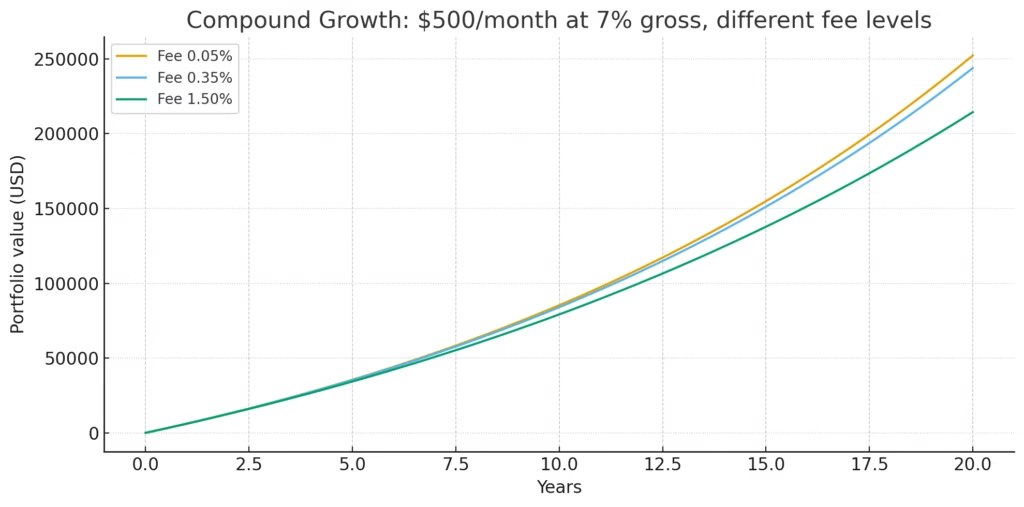
Example of a Developed Market Growth Fund Strategy
One strong example from the US market is the Vanguard Developed Markets Index Fund, also known as VTMGX. It is often considered one of the best mutual funds for developed markets because of its very low expense ratio of 0.07 percent. The fund provides exposure to more than four thousand stocks in Europe, Canada, and Asia. It is designed to deliver mutual funds for long term growth, not quick speculation.
Other major fund providers such as Fidelity and BlackRock also offer developed market growth funds 2026 that focus on advanced economies while keeping expense ratios competitive. By including such funds in your portfolio, you are not just investing in one country. You are investing in the collective strength, stability, and innovation of multiple developed markets at once.
we explored why low cost mutual funds are becoming a preferred choice and why developed market growth funds 2026 hold strong potential. In this section, we will compare mutual funds across developed markets, discuss key risks to watch for, and highlight real-world case studies from Tier 1 investors.
How to Compare Low Cost Mutual Funds Across Developed Markets
Selecting the best mutual funds for developed markets is not as simple as choosing the one with the lowest fees. Investors need a structured comparison method to make informed choices.
Regional Exposure
Some developed market funds are weighted toward Europe, while others concentrate more on Asia-Pacific. For example, a fund with 40 percent invested in the United Kingdom and Germany will respond differently to global events than a fund with 40 percent invested in Japan and Singapore. Investors must decide whether they want a globally diversified fund or prefer to emphasize specific economies such as the United States or Australia.
Sector Allocation
Different developed markets excel in different industries. The United States dominates in technology and healthcare. The United Kingdom is stronger in financial services and consumer staples. Germany and Japan rely heavily on industrial manufacturing and automobiles. Australia and Canada are resource-focused economies that thrive in mining and energy. Evaluating a fund’s sector allocation ensures that its composition matches your expectations for long-term growth.
Historical Performance
Examining a fund’s five-year and ten-year average returns offers a perspective on its reliability. However, the true test is whether the fund has consistently outperformed benchmarks such as the MSCI World Index.
Dividend Policies
Some developed market funds distribute dividends. Investors who reinvest dividends can significantly improve their compounding over the long term. Checking whether dividends are reinvested automatically or paid out separately is important for aligning with your strategy.
Currency Risks
Developed market funds expose investors to currencies like the Euro, Yen, and Pound. Currency fluctuations can amplify or reduce returns. While currency-hedged funds can lower volatility, they may also slightly reduce performance. Understanding how a fund manages this risk is essential.
Investors often compare international mutual funds with direct stock investing. To understand these distinctions better, see our article on the Difference Between Stocks and Mutual Funds.
Risks in Developed Market Growth Funds 2026
Although mutual funds for long term growth provide stability and diversification, they are not free from risks. Recognizing these risks helps investors prepare better.
Currency Fluctuations
For example, if you invest in a Japanese fund and the Yen weakens against the US Dollar, your dollar-denominated returns may decline even if the fund performs well in Japan. Investors who are sensitive to such risks may prefer funds that include currency hedging.
Market Saturation
Developed markets, while stable, can experience slower growth than emerging economies. Their industries are mature, which can limit growth opportunities. A balanced portfolio that includes a small portion of emerging market funds can counter this limitation while still keeping stability.
Economic Shocks
Even developed economies face recessions. The 2008 financial crisis showed that the US and European markets are not immune to downturns. Spreading investments across multiple regions and sectors is a practical way to minimize exposure to localized shocks.
Management Risk
Fund managers play an important role even in low cost mutual funds. A manager making overly aggressive bets can increase risk. Reviewing the fund manager’s philosophy, experience, and long-term approach ensures you understand how the fund is being run.
Consider this scenario. If a fund manager shifted 20 percent of assets into riskier technology startups in an effort to pursue higher returns, would you remain invested, trusting the manager’s judgment, or would you move your capital to a more stable developed market growth fund? This question highlights how investor psychology influences decisions just as much as market conditions.
Real-World Case Studies: Tier 1 Investors in Developed Market Funds
Practical examples help illustrate how different investors apply these strategies in real life.
United States Investor Building a Retirement Portfolio
Sarah is a 35-year-old professional in California. She invests one thousand dollars each month into a developed market index fund with a 0.05 percent expense ratio. Her focus is mutual funds for long term growth, with exposure across the United States, the United Kingdom, and Japan. With consistent contributions and compounding, she is projected to accumulate more than half a million dollars by 2046.
United Kingdom Investor Diversifying Globally
James, age 40, lives in London. He allocated 60 percent of his investments into United Kingdom and European developed market funds, and 40 percent into North America and Asia-Pacific funds. His intention was to balance the uncertainty of Brexit with exposure to United States technology and Asian manufacturing. His portfolio has averaged about 8 percent annual growth with lower regional risk.
Singaporean Investor Planning Early Retirement
Aisha is 30 years old and based in Singapore. She chose the best mutual funds for developed markets in Australia, the United States, and Canada. Her decision was influenced by the stability of these currencies and consistent long-term growth prospects. She reinvests dividends automatically, turning her portfolio into a compounding engine that she expects will allow her to achieve financial independence by 2040.
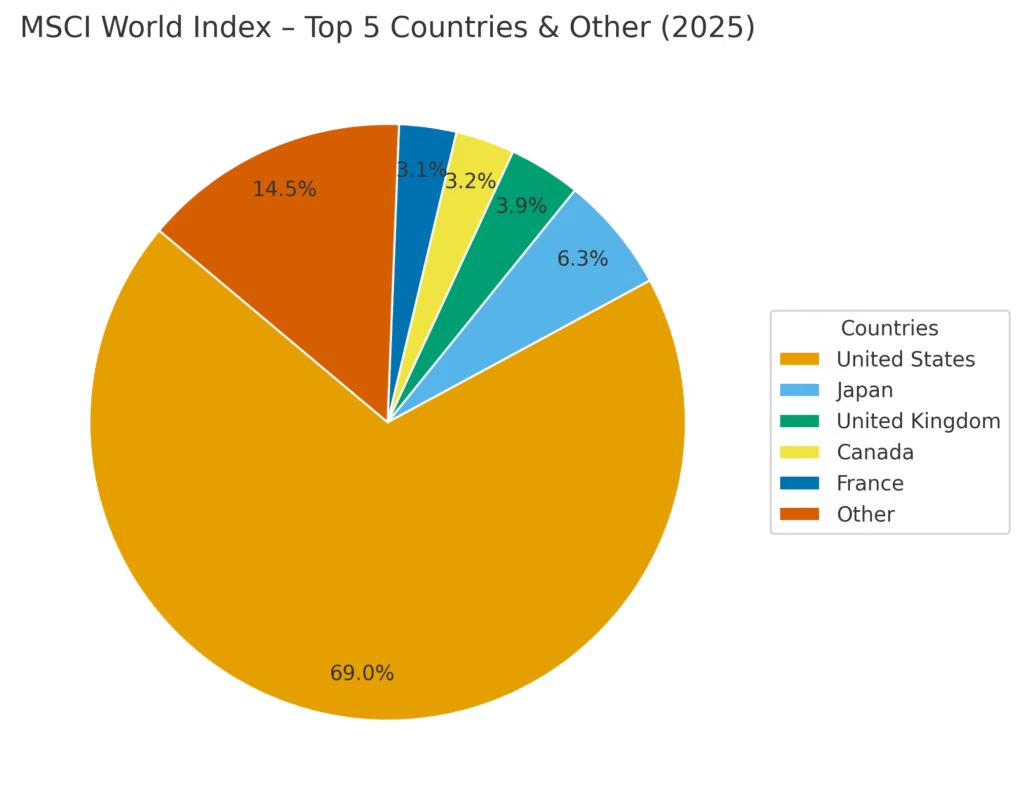
Many developed market funds are benchmarked against the MSCI World Index, which tracks stocks across 23 advanced economies.
The Role of Technology in Mutual Fund Selection
By 2026, investors are more empowered than ever, thanks to financial technology tools that simplify fund selection and monitoring.
Robo-advisors such as Betterment, Wealthfront, and Nutmeg analyze investor goals and recommend portfolios of low cost mutual funds that match those objectives.
Fund screening tools like the Morningstar Fund Screener allow comparisons by region, returns, fees, and risk profiles.
Artificial intelligence platforms are also emerging, offering predictive insights on fund strategies and helping investors create optimized portfolios for long-term growth.
Example Comparison of Developed Market Growth Funds
To illustrate how funds differ, here is a comparison of three examples. This is for educational purposes only and not financial advice.
| Fund Name | Region Focus | 10-Year Average Return | Dividend Policy |
|---|---|---|---|
| Vanguard Developed Markets Index Fund (VTMGX) | US, Europe, Japan | ~8% | Reinvested |
| Fidelity International Growth Fund (FIGFX) | Europe and Asia-Pacific | ~7.9% | Paid Annually |
| BlackRock Developed Markets ETF (e.g., IDEV or similar) | Global Developed | ~7.8% | Reinvested |
Even small variations in expense ratios, regional weightings, and dividend policies can lead to very different outcomes over twenty years of compounding.
One strong example is the Vanguard Developed Markets Index Fund (VTMGX), which has an expense ratio of just 0.07%.
Other providers such as Fidelity and BlackRock also offer competitive developed market growth funds.
Questions For You
Which region do you believe offers the strongest long-term growth potential: North America, Europe, or Asia-Pacific? Would you prefer one global developed market growth fund 2026, or several funds divided by region?
Reflecting on these questions helps clarify your own investment style. Sharing such perspectives also benefits the broader investor community by sparking meaningful conversations.
In the earlier sections, we looked at why low cost mutual funds are powerful tools for investors, how to evaluate the best mutual funds for developed markets, and what risks to prepare for. We also explored real-world examples of investors from Tier 1 countries who are actively using developed market growth funds 2026 to build wealth. Now let us bring everything together with portfolio-building strategies, actionable steps for 2026 investors, and final insights to help you make confident investment decisions.
Building a Long-Term Growth Portfolio with Low Cost Mutual Funds
A well-structured portfolio balances growth, diversification, and stability. Here is a practical approach for 2026 investors who want to maximize the benefits of low cost mutual funds while focusing on developed markets.
Step One: Define Your Investment Horizon
If you are investing for retirement 20 or 30 years away, your portfolio can lean more heavily toward mutual funds for long term growth. If your horizon is shorter, you may need a blend of growth and income-focused funds to reduce risk.
Step Two: Allocate by Region
Many investors choose a global developed market fund that automatically spreads exposure across North America, Europe, and Asia-Pacific. Others prefer to hold separate funds for each region to fine-tune the balance. For example, a young investor in Canada may allocate 50 percent to US-focused funds, 25 percent to European markets, and 25 percent to Asia-Pacific.
Step Three: Diversify by Sector
Sector allocation ensures your portfolio does not rely on the fortunes of one industry. Technology and healthcare may deliver high returns, but consumer staples and financials provide stability. The best mutual funds for developed markets are those that blend these sectors effectively.
Step Four: Minimize Costs
Keep expense ratios low. Every fraction of a percent saved each year can compound into thousands of dollars in extra returns over decades. This is the central advantage of low cost mutual funds.
Step Five: Rebalance Regularly
Markets shift over time. Rebalancing once or twice a year ensures your portfolio stays aligned with your goals. This discipline prevents your portfolio from becoming overweight in sectors or regions that have experienced short-term surges.
Actionable Steps for Investors in 2026
Let’s ready to take action, here are specific steps to get started with developed market growth funds 2026.
- Research low cost mutual funds from leading providers such as Vanguard, Fidelity, and BlackRock. Compare expense ratios, regional exposure, and historical performance.
- Start small if necessary. Even a monthly contribution of a few hundred dollars can grow into a significant sum with consistent investing.
- Use technology to your advantage. Fund screeners and robo-advisors can simplify choices and keep you disciplined.
- Focus on long-term goals instead of reacting to daily market news. Developed markets are stable enough to reward patience.
- Engage with financial communities, either online or locally, to learn from other investors. Discussions around the best mutual funds for developed markets can reveal strategies you may not have considered.
Why 2026 is a Turning Point for Developed Market Funds
Economic conditions in 2026 present a unique opportunity for investors. Developed economies are embracing artificial intelligence, green energy, and digital finance at a scale not seen before. Regulatory frameworks are more transparent, making markets safer for long-term investors. And compared to emerging markets, developed economies are better equipped to handle inflationary pressures and global shocks.
For investors seeking mutual funds for long term growth, this environment offers both safety and innovation. Developed market growth funds 2026 are positioned to capture these opportunities while maintaining the cost efficiency that makes low cost mutual funds so effective.
Final Thoughts on Long-Term Growth
Low cost mutual funds are more than just a cost-saving choice. They are a disciplined approach to building wealth that allows investors to benefit from the collective strength of developed markets. By 2026, the best mutual funds for developed markets will not only provide diversified exposure but also minimize risks through careful management and stable growth strategies.
The key is consistency. Whether you are in the United States, the United Kingdom, Canada, Singapore, or Australia, the principles remain the same. Invest steadily, choose funds with low fees, diversify across regions and sectors, and let compounding work in your favor.
Before closing, let me leave you with a reflective question. If you had the option to invest only in one region’s developed market growth funds 2026 for the next twenty years, would you choose North America for its technology leadership, Europe for its stability, or Asia-Pacific for its innovation potential?
Think about your answer and share your reasoning in comment section. Different perspectives often reveal strategies others may not have considered.


